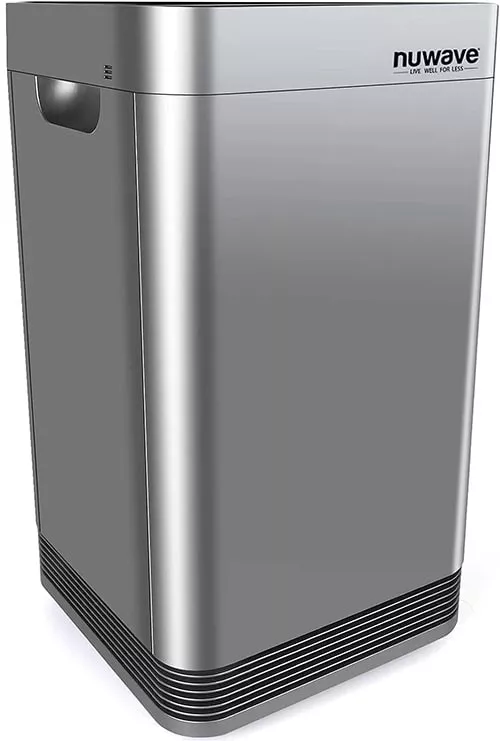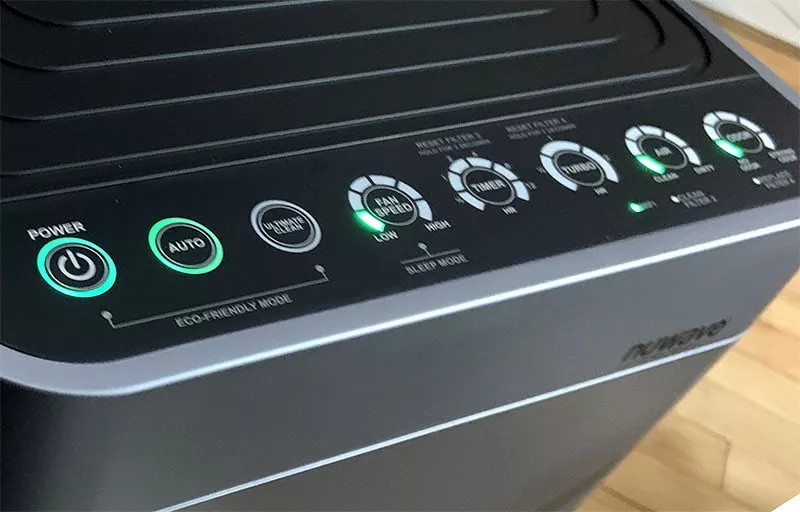The Nuwave OxyPure is one of the best-selling large air purifiers online. It’s time I put my hands on it and review it!
When I look for an in-depth Nuwave OxyPure review, I am surprised there is so little actual insight available. I mean there is plenty of information. But everybody just tries to sell you this air purifier, without consideration.
And let me tell you: The Nuwave OxyPure is not the best choice for everybody.
I see it as my duty to shed some light into the dark! What the heck can be wrong with this air purifier?
In this Nuwave OxyPure review, I am going to tell you the good and the bad, in a digestible format.
And after reading, you’ll know exactly whether you should get the Nuwave OxyPure or not. And if you figure the Nuwave OxyPure is not your choice, you’ll get to know the best alternatives for this model!
Here’s a quick outline of what we’re going to find out about:
- What the Nuwave OxyPure excels at: Air purification, sturdiness, lifespan and design
- What the Nuwave OxyPure lacks: A thorough sensor system (when compared to other air purifiers at that price point), a proper air intake design, portability
- Whether you should buy the Nuwave OxyPure
So, let’s start:

The Pros: What Makes the Nuwave OxyPure Stand Out
5-Stage Filtration System: 100% Clean Air
There is no doubt that the Nuwave OxyPure(click here to view it on amazon) is a great air purifier. It uses 5 stages of air filters:
- Stainless Steel Pre-Filter: Washable, lasts for 20 years.
- Bio-Guard Filter: Washable, lasts for 20 years.
- Ozone Emission Removal Filter: Reusable, lasts for 20 years. But not washable!
- HEPA + Activated Carbon Combo Filter: Lifespan, 6 months to 1 year. Not Washable.
After passing through all these filtration layers whatever comes out the other end of the air purifier is definitely clean.
Nuwave OxyPure collects 100% of particles down to 0.09 microns
Nuwave states that their filtration system captures 100% of particles down to 0.09 microns. That’s a bold statement. How can they be so sure it’s 100%?
Here’s why: There are studies that show that HEPA filters catch different particle sizes differently well. One thing is obvious: A HEPA filter can easily catch large particles.
Now you might assume that smaller particles are harder to catch. Which they are. But only down to a size of 0.3 microns.
Below this critical size limit, particles are, again easier to catch. These too-small particles are so lightweight, they wiggle around a lot due to Brownian motion that their chance of being caught increases to close to 100%.
Actually, 0.3-micron particles are hardest to catch!
The marketing statement “Captures 100% of particles down to 0.09 microns” is misleading. Particles that are 0.09 microns are easy to catch for any HEPA filter, not just Nuwave’s.
Still, a 100% particle collection rate is noteworthy! But I am sure they rounded numbers. Likely, it was something like 99.9999%.
Nothing is 100% in nature.
 The best thing about the Nuwave OxyPure is literally the filtration system. You get multiple filter stacked on top of each other. And most filters are washable!
The best thing about the Nuwave OxyPure is literally the filtration system. You get multiple filter stacked on top of each other. And most filters are washable!
OxyPure Ozone Removal: Unique among air purifiers
“The CARB-Certified OxyPure®’s Ozone filter drops the ozone concentration in your home to 1ppb, 70 times lower than current EPA limits”
Ozone removal tests were performed by Intertek Labs. Nice!
Tested in the USA. That’s a good sign.
Since ozone has a direct effect on health, reducing exposure to the harmful gas is very good for you!
The Nuwave OxyPure is the only air purifier (I know) that drops ozone levels. Regular HEPA-filter air purifiers don’t collect ozone.
Some air purifiers, such as ionic purifiers or (as the name suggests), ozone generators, even increase ozone concentration.
The Nuwave OxyPure really stands out with its ozone filter!
Generous Filter Supply: 4 Filters for free
When you buy a Nuwave OxyPure air purifier, you don’t get just 1 HEPA filter pre-installed into the air purifier.
You get 4 extra replacement filters for free!
I love that!
Since HEPA filters last only 6-12 months, it’s always annoying to have to shop for replacement filters so soon after getting an air purifier.
With the replacement filters included you can run your Nuwave OxyPure for 2 to 4 years with the included filters alone!
This shows care for the customer. Other air purifier brands, such as Coway or Dyson, really take profit from the replacement filter market.
Ideal airflow: Air intakes close to the floor
Instead of looking only at what Nuwave themselves already state about their OxyPure air purifier, I also like to also do my own little investigation.
One thing that sticks out the me is the air intake location.
The air intake is a band of slits along the bottom part of the air purifier’s body. That’s good!
Since the Nuwave OxyPure’s air intake is close to the ground, it can create a draft of air along the floor and pick up particles from the floor more easily.
Auto & Turbo mode
Many air purifiers, even at lower price tags have this, but it’s a noteworthy feature:
The Nuwave OxyPure has an auto mode at which it monitors indoor air pollution levels. Accordingly, to keep air pollution down, it sets the fan speed.
This feature allows you to run your Nuwave OxyPure air purifier 24/7.
 You get a very nice monitoring & control panel with the Nuwave OxyPure!
You get a very nice monitoring & control panel with the Nuwave OxyPure!
The Cons: Where the Nuwave OxyPure Falls Short
Air Quality Indicators: Misleading names & too few metrics
Nuwave advertises that the Nuwave OxyPure has two built-in air quality sensors. One measures “Air quality” the other measures “Odor” levels.
I am really curious about what the odor sensor actually is. Because it is definitely not an odor sensor.
After all, how can a machine judge odors? It would need to sense different molecules and know which ones humans perceive as odors.
Probably the “Odor” sensor senses volatile organic compounds or some other gases.
And the sensor called “Air” probably measures the amount of particles down to 2.5 microns.
But it is an enigma why Nuwave doesn’t name their sensor accordingly.
They could have just named them PM2.5 (a common name for 2.5-micron particle sensors) and VOCs (a common name for volatile organic gases), instead of “Air” and “Odor”.
Additionally, they emphasize that most other air purifiers have only one air quality monitoring sensor. Which is true.
But not at this price range.
For comparison, Dyson air purifiers, which cost roughly the same as the Nuwave OxyPure, have a whole set of air quality sensors:
- pollen and dust levels (PM 10)
- smoke, bacteria, and allergen levels (PM 2.5)
- nitrogen dioxide levels (NO2)
- volatile organic compound gas levels ( VOC)
Dyson air purifiers come with 2 particulate and 2 gas sensors!
So, the lack of detailed monitoring is a shortcoming of the Nuwave OxyPure.
This obviously does not impact how well the Nuwave OxyPure purifies the air. But if I pay $500 for an air purifier, it surely should monitor better.
Too Few Air Intakes: More is always better
Now let’s talk about the design of the air intake.
In top-tier air purifiers, like the ones from Dyson or Coway, you’ll typically see a large number of intake holes around the unit.
This design increases the surface area for air to flow through, effectively speeding up the purification process.
In the Nuwave OxyPure, the air intake is limited to a band of slits located near the bottom of the device.
While the low positioning is good for catching floor-level particles, the limited number of slits could potentially slow down the purification process.
It may not be a deal-breaker, but it’s an area where the Nuwave OxyPure could be better, especially considering its price point.
Compare it with the Coway Airmega 400 (click here to view it on amazon):
 For comparison: The Coway Airmega 400 has much more air inlet holes!
For comparison: The Coway Airmega 400 has much more air inlet holes!
Weight
Here’s something I really don’t get. The Nuwave OxyPure weighs in at almost 27 pounds. Why? I mean, we’re talking about a fan with filters.
Luckily, the Nuwave OxyPure comes with four wheels for better portability, but I’ve got to be honest
An air purifier really shouldn’t need wheels to begin with.
There is nothing inherently heavy about the components of a high-quality air purifier, and if other brands can keep the weight down, Nuwave should consider doing the same.
Should You Buy the Nuwave OxyPure?
Here’s the deal: If you’re looking for an air purifier with superb filtration and a unique ozone filter, the Nuwave OxyPure is an excellent choice. The additional filters you get when buying it certainly make it cost-effective in the long term.
I recommend getting the Nuwave OxyPure air purifier here (click to view it on amazon).
However, if monitoring a broad range of air quality metrics is important to you, and if you value a more portable and efficient design, then you might be better off with another model, especially if you’re willing to pay around $500.
Dyson models, for instance, offer a more comprehensive array of sensors and are generally lighter.
Conclusion
The Nuwave OxyPure stands strong in terms of air purification, ozone reduction, and long-term cost-effectiveness with its extra filters.
It’s certainly no slouch in doing what it’s designed to do: purify the air in your home.
But it doesn’t exist in a vacuum. Its sensor system could definitely be more detailed, and it could benefit from a design overhaul focused on increased air intakes and reduced weight.
So, is it the right air purifier for you? That depends on what you prioritize. If you’re looking for top-notch air purification and can overlook the minor flaws, go ahead and make the purchase.
